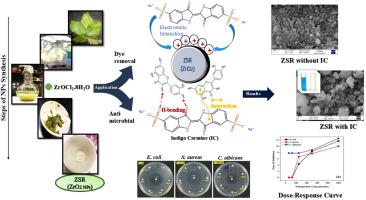通过植物合成的结晶ZrO2纳米颗粒对紫外线驱动的染料吸附和抗菌活性:一种双功能方法
IF 4.7
2区 化学
Q2 CHEMISTRY, PHYSICAL
引用次数: 0
摘要
本研究以赤芍叶提取物为天然封盖还原剂,用于植物合成氧化锆纳米颗粒(ZSR)。采用紫外可见光谱、FTIR、XRD、BET、SEM/EDS、HRTEM和XPS等方法对纳米颗粒进行表征。219 nm处的特征吸收峰证实了ZrO₂的形成,ZrO₂主要为四方晶相,平均粒径为~ 10 nm。在不同的pH、投加量、初始浓度和接触时间条件下,考察了ZSR对酸性蓝74(靛蓝胭脂红)染料的吸附性能。在紫外辅助条件下,ZSR的最大去除率为98%。拟二阶模型最能描述动力学数据,而平衡数据符合非线性Freundlich等温线,具有较高的R²值和较低的误差函数。在抗菌试验中发现对金黄色葡萄球菌、大肠杆菌和白色念珠菌有显著的抑制作用。后者表现出最强的反应,在62.5µL时的抑制带为7.0±0.33 mm。这些结果表明,ZSR是一种具有双重功能、成本效益高、可重复使用的纳米材料,在废水处理和微生物控制方面具有广阔的应用前景。本文章由计算机程序翻译,如有差异,请以英文原文为准。

Crystalline ZrO2 nanoparticles via phyto-synthesis for UV-driven dye adsorption and antimicrobial activity: A dual-functional approach
In this study, leaf extract of Shorea robusta was used as a natural capping and reducing agent for phyto-synthesis of zirconium oxide nanoparticles (ZSR). UV–Vis spectroscopy, FTIR, XRD, BET, SEM/EDS, HRTEM, and XPS studies were used to characterize the nanoparticles. A characteristic absorption peak at 219 nm confirmed the formation of ZrO₂, which exhibited a predominantly tetragonal crystalline phase with an average particle size of ∼10 nm. The adsorption performance of ZSR was evaluated for Acid Blue 74 (Indigo Carmine) dye under batch conditions by varying pH, dosage, initial concentration, and contact time. Under UV-assisted conditions, ZSR achieved a maximum removal efficiency of 98%. The pseudo-second-order model best described the kinetic data, while equilibrium data fitted the non-linear Freundlich isotherm, supported by higher R² values and lower error functions. Significant inhibitory action against Staphylococcus aureus, Escherichia coli, and Candida albicans was found in antimicrobial testing. The latter exhibited the strongest response, with an inhibition zone of 7.0 ± 0.33 mm at 62.5 µL. These results establish ZSR as a dual-functional, cost-effective, and reusable nanomaterial with promising applications in wastewater treatment and microbial control.
求助全文
通过发布文献求助,成功后即可免费获取论文全文。
去求助
来源期刊

Journal of Molecular Structure
化学-物理化学
CiteScore
7.10
自引率
15.80%
发文量
2384
审稿时长
45 days
期刊介绍:
The Journal of Molecular Structure is dedicated to the publication of full-length articles and review papers, providing important new structural information on all types of chemical species including:
• Stable and unstable molecules in all types of environments (vapour, molecular beam, liquid, solution, liquid crystal, solid state, matrix-isolated, surface-absorbed etc.)
• Chemical intermediates
• Molecules in excited states
• Biological molecules
• Polymers.
The methods used may include any combination of spectroscopic and non-spectroscopic techniques, for example:
• Infrared spectroscopy (mid, far, near)
• Raman spectroscopy and non-linear Raman methods (CARS, etc.)
• Electronic absorption spectroscopy
• Optical rotatory dispersion and circular dichroism
• Fluorescence and phosphorescence techniques
• Electron spectroscopies (PES, XPS), EXAFS, etc.
• Microwave spectroscopy
• Electron diffraction
• NMR and ESR spectroscopies
• Mössbauer spectroscopy
• X-ray crystallography
• Charge Density Analyses
• Computational Studies (supplementing experimental methods)
We encourage publications combining theoretical and experimental approaches. The structural insights gained by the studies should be correlated with the properties, activity and/ or reactivity of the molecule under investigation and the relevance of this molecule and its implications should be discussed.
 求助内容:
求助内容: 应助结果提醒方式:
应助结果提醒方式:


